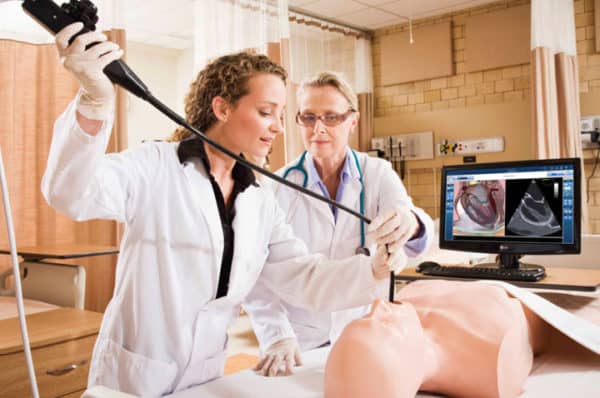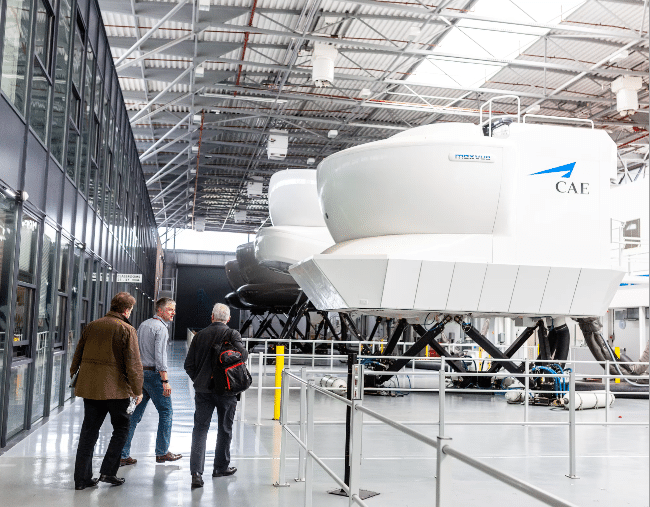Why is CAE betting so big on the Medical Simulation Market?

CAE Inc. (TSX:CAE), which was founded in 1947 in Saint-Hubert, Quebec has built a billion dollar business on the back of flight simulators.
The company is the gold standard in the industry, having sold their simulators to over a hundred different airlines. The company now trains more than 75,000 crew members each year, many at its at 426,000 square foot facility at the Dallas/Fort Worth International Airport, which is largest business aviation training facility in the world.
And while CAE says it is still experiencing growth in their bread and butter market, with CEO Marc Parent recently noting that “We continue to experience a high level of activity for full-flight simulator sales and upgrades to existing simulators. The company is now also touting its diversity, which Parent says will make CAE “a pretty good port in the storm.”
CAE now boasts product offerings it divides into five segments, its core aviation training and services, military services, public safety and security, mining, and healthcare.
Of these, CAE seems particularly aggressive in the healthcare field. The company has made two major acquisitions in an emerging area of healthcare called Medical Simulation. In March of 2010, CAE acquired three medical simulation product lines from Immersion (NASD:IMMR), which CAE says will form will form the core offerings of CAE Healthcare’s newly established surgical simulation division.
“We are committed to delivering the best training solutions to improve patient safety, and the acquisition of Immersion’s surgical training systems will accelerate our entry in the growing surgical simulation market,” said Guillaume Hervé, President of CAE Healthcare. “
Then, this past August, CAE doubled down on the commitment and acquired Medical Education Technologies, Inc. for (US)$130 million. METI simulators include those designed to mimic human medical scenarios including trauma, heart attacks and drug overdoses.
_________
This story is brought to you by Cantech Letter sponsor Verisante (TSXV:VRS). Verisante just received Health Canada approval for Aura™, the company’s skin cancer detection device. Click here for more information.
_________
So what is medical simulation?
Dr. Jeff Bauer is author of a 2006 white paper called The Future of Medical Simulation: New Foundations for Education and Clinical Practice. Bauer says “medical simulation will proliferate in the coming years as academic health centers and hospital systems find themselves stuck in an increasingly vicious cycle of personnel shortages.” He warns the current model of hands on training for health professionals is unsustainable, and that without the use of new technologies, hospitals will face severe staff shortages and government budgets will be busted by trying to fill the void with training programs.
Bauer sees three particular immediate areas of growth in medical simulation technology. The first is in human patient simulators -think the CPR rescue dummy gone bionic. Advances in engineering and miniaturization means the clinical scenarios in which these dummies can be used has increased ten-fold in recent years CAE’s material describes theirs as “the most advanced models of the human cardiovascular, respiratory, neurological and pharmacologic systems available today, and their integrated, coupled function imitates the human response in the multi-layered, real-time ways that are vital to a true learning experience.”
The second area of growth, Bauer notes, is another recent focus of CAE; virtual simulation that “employs the latest advances in computer technology and visual interfaces to create acceptably realistic learning experiences.
The third area, called Haptics, is the core of the Immersion expertise CAE acquired in 2010. Haptics describes technology that interfaces with the user through the sense of touch. This type of tactile feedback technology is already used in game controllers and smart phone dial pads. Immersion describes one use in medical technology. “When simulating the placement of cardiac pacing leads, a user can feel the forces that would be encountered when navigating the leads through a beating heart, providing a more realistic experience of performing this procedure.”
The field of medical simulation is just emerging, so realistic assessments as to its size are, at best guesses. But in places like Central Florida the practices are already taking off.
“This is the world hub for modeling simulation and training,” said Randy Shumaker, Director of the Uuniversity of Central Florida’s Institute for Simulation & Training. “And we think medical simulation is the next great frontier.” In fact, says Shumaker, “the medical simulation market is expected to be bigger than the military simulation market.”
_______
________
Nick Waddell
Founder of Cantech Letter
Cantech Letter founder and editor Nick Waddell has lived in five Canadian provinces and is proud of his country's often overlooked contributions to the world of science and technology. Waddell takes a regular shift on the Canadian media circuit, making appearances on CTV, CBC and BNN, and contributing to publications such as Canadian Business and Business Insider.

